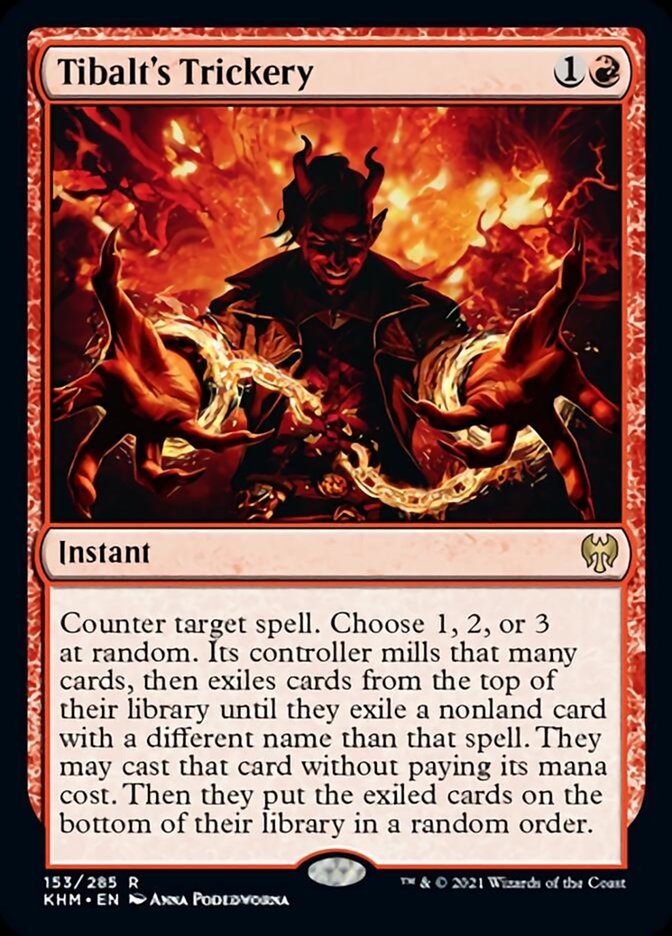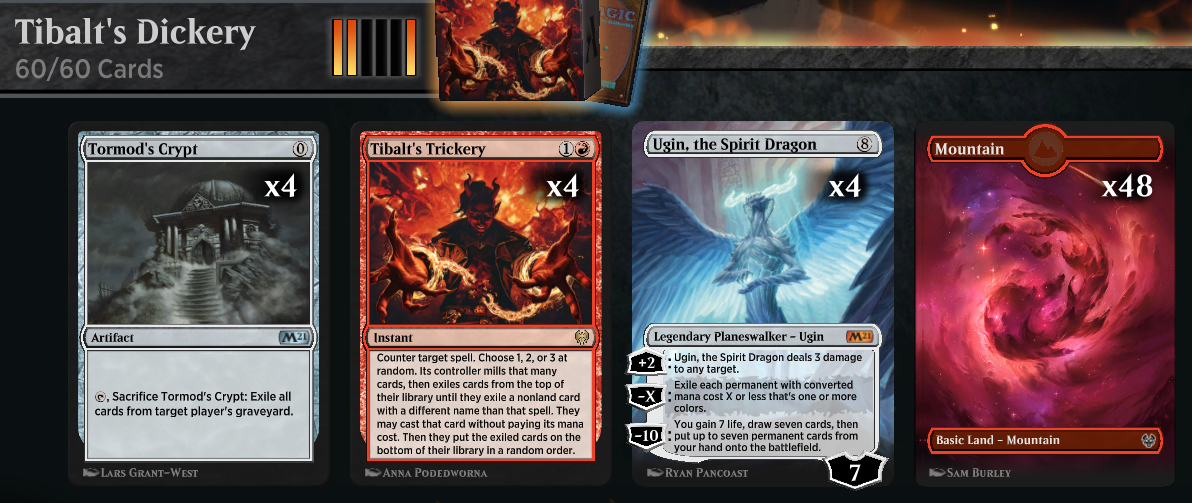Kaldheim’s Hottest New Combo Can’t Last for Long
Magic: the Gathering's newest set, Kaldheim, has just launched in both the classic cardboard tabletop version, and digitally on MTG Arena. And with its release comes 285 new cards to play with, adding to a vast catalogue that stretches back almost 30 years.
And while I had long been excited to see how all these new additions would change the game, upon my first day playing with them, I became fixated on a single card, and the amazing combo it can unleash.
Behold! Tibalt's Trickery.
On the face of it, it's a carefully balanced, out-of-color counterspell. Countering spells is really Blue's domain, and Red is one of Blue's mortal enemies and opposites, so the capability to counter in Red has to come with some major caveats. In this case, the poor spellcaster whose spell you counter gets to replace it with another free – though randomly selected – spell. And to prevent you from gaming this drawback for your own nefarious purposes, by devising some sort of way to choose which spell will be the replacement, they've added the part about milling 1, 2, or 3 cards off the top of the deck first.
Well, despite the game designers' best intentions, Tibalt's Trickery has nevertheless been gamed!
I first heard of this combo from Merchant on Youtube: by using Tibalt's Trickery to counter your own spell, you then get a random free one. But if the only spells in your deck are the Trickery itself, a cheap spell to counter, and then something massive and terrifying like, oh I don't know – maybe Ugin, the Spirit Dragon – then your opponent can have a truly unsolvable problem on their hands before their second turn of the game. That's pretty devastating.
On the day Kaldeim came out, I decided to do a little scientific research on the strategy, and what follows is the documentation of my magical experimentation:
What I found was that a pure Tibalt combo has a 20% win ratio in Standard.
In 1 hour's time I played 30 ranked games, and won 6 of them. (I was starting from the very bottom of the ranking system, called Bronze Tier 3, and by the end had made it up to Bronze Tier 1.)
The rules of Magic state that if you don't like your opening hand for any reason, you can reshuffle and draw again, but then you must return one card from your hand to the bottom of your deck. This is called a mulligan, and you can do it as many times as you like, but at the cost of losing a card from your hand each time you redraw.
Well, for a deck that absolutely needs to get a two-card combo to work, I needed to mulligan. A LOT. Every single game. To test how well this combo could work, I played each game the same way: I would take the mulligan each and every time, no matter what, until I either had BOTH parts of the combo in my opening hand (the Crypt and the Trick), or until I had zero cards in my hand – and in that case, I would lose.
Out of those 30 games, that meant I lost 18 of them before we even started playing, because I didn't get both the Crypt AND the Trick in my opening hand. By contrast, in 10 of those games I drew what I needed with 3 or fewer mulligans. In only 2 games did I find both cards after 4 or 5 mulligans.
But that was only the prototype! Armed with the knowledge of how the combo worked in such extreme isolation, I was ready to expand it into a more effective version. That gave way to this beautiful monstrosity, 4 Color Tibalt:
In just over 2.5 hours (which saw me go from Bronze 1 to Silver 1), I played another 30 games with this fine piece o' deck you see right here, *slaps roof*, and came away with 15 wins – more than twice that of the initial prototype design.
That means 4 Color Tibalt wins 50% of games!
First, with double the counter outlets (Serpent and Crypt), you only ever need to mulligan down to make sure you get the Trickery, a much easier feat than trying to get both parts at once. With just the Trickery in hand, you can reliably count on drawing one of the other 8 cards you need to combo off.
The addition of more combo components (any one of which you can accidentally Trickery yourself into) is then offset by the huge increase in win-conditions: not just Ugin, but Godzilla – who is, by the way, far more lethal. Plus Garruk and the Ultimatum are each quite nasty, too. (The Beast and the Dragon won't win on their own, but they're still pretty good plays on turn 2. Besides, they're in there for another reason, coming up below.)
One of the most painful parts about playing the prototype was that, assuming you could even pull the combo off, you only had a slightly-better-than 50% chance of actually combo’ing into Ugin. The other 40-whatever-% of the time, you'd run into one of your 3 other copies of Tibalt's Trickery (and then of course, promptly lose). Well, this is extremely well mitigated by the presence of so many other cards to combo into (21 cards versus 4), ensuring maximum payoff.
The other major problem with the prototype was its lopsidedness: if you didn't get the precise combo off, you were absolutely dead. There was no backup plan. So, the expansion into 4 colors fixes that. Now, without the combo, we just have a very slow deck instead of nothing at all. If it can survive until turn 5, there's a decent chance it can still compete, and even sometimes win from a disadvantaged position.
This is where the Beast and the Dragon come in to save the day. They're not the ideal targets for Trickery, but if the game isn't over by turn 5, then they become the front line of defense. Their job is to keep you alive long enough to hard cast the even bigger spells, or until you draw into the combo again. (It's worth noting that more than a few mid-to-large Stonecoil Serpents stood in the way of plenty of attacks, too.)
Synergistically, the Beast even helps you to draw more cards while he's defending. So does Godzilla, for that matter, and also late-game Triomes. So it was happily not very uncommon to combo off twice in some games.
Conclusion: Lab results indicate (and I project) that Tibalt's Trickery will be banned inside of 3 months. There's just not much to be done about a turn 2 Garruk, or Ugin, especially when that turn 2 play is consistent and reliable.
So I would say, play 'em while you got 'em! It's a ton of fun.







